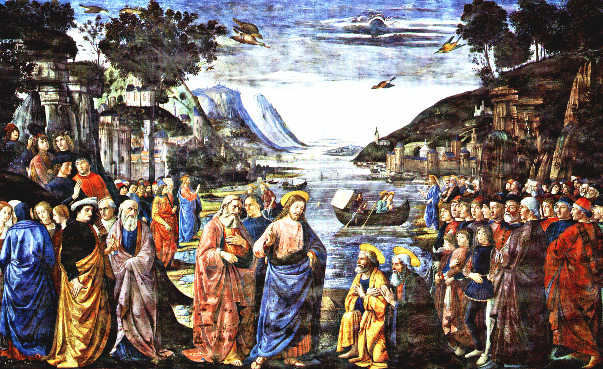And he called unto him the twelve and began to send them forth by two and two; and gave them power over unclean spirits..." (Mark 6:7) |
 |
And he called unto him the twelve and began to send them forth by two and two; and gave them power over unclean spirits..." (Mark 6:7) |
 |
"These twelve Jesus sent forth, and commanded them, saying, 'Go not into the way of the Gentiles and into any city of the Samaritans enter ye not' "(Mt 10:5)If the actual number and pairing of the twelve was so vital to Jesus' ministry, it is strange that the divinely-inspired writer of Matthew's Gospel did not see fit to mention this detail. He does elucidate, however, what the specific instructions to the twelve actually were; the instructions were specifically directed at the twelve apostles (not workers 1,900 years later) for a specific, and limited mission "to the lost sheep of the House of Israel" (Mt 10:6). Everyone knows that God's original chosen people were the children of Abraham:
"for you are a people holy to the LORD your God. Out of all the peoples on the face of the earth, the LORD has chosen you to be his treasured possession." (Deut 14:2)As such,even Jesus at first told the woman in Mt 15:24, "I am not sent but unto the lost sheep of the House of Israel". In other words, this commission was a limited assignment to prepare the Jews for the coming of the Messiah, so if the workers were to be consistent, they would only preach to Jews, not Gentiles, since is wasn't until much later that Gentiles were added to the church (Acts 9). We know the mission was a limited one because after being sent out two by two (Lk 10:1), the 70 joyfully returned sixteen verses later (Lk 10:17) to tell Jesus how things went.
"And He said unto them, 'When I sent you without purse, and scrip, and shoes, lacked ye anything?' And they said, 'Nothing' "Jesus was preparing them for a more extended gospel mission, with Peter as their leader (Lk 22:32, Jn 21), as He told them to "Go ye therefore, and teach all nations, baptizing them in the name of the Father and of the Son, and of the Holy Spirit" (Mt 28:19). This command says absolutely nothing about going out two by two, and in fact they did not always go out two by two. For example, Paul and Barnabas often went together, but recall that Luke also was their companion for much of the time. Often times there were more people, like Acts 13:1, where there as Barnabas, Simeon, Lucius of Cyrene, and Manean, and Saul, and Herod the tetrarch - note also that when Paul and Barnabas were separated from them (Acts 13:2), they were joined by John as a minister as well until Perga in Pamphylia. Another example is after the Council of Jerusalem, Paul and Barnabas were accompanied by Judas and Silas to deliver the letter from the council. For such emphasis to be placed on a 2x2 ministry, it becomes clear that the workers, in reality, don't actually consistently follow the activities of the New Testament church. The article on the TTT website sums it up nicely:
"In Acts, one person went alone on an evangelistic journey (10) times, often Paul; pairs going "two and two" are mentioned (8) times; three persons went (7) times; four persons went (1) time; seven persons (1) time; eight persons (1) time; ten persons (1) time; two persons plus an unspecified number (1) time; three persons plus an unspecified number (1) times. The disciples went "two and two" only eight times out of 29 in Acts, or 28% of the time."One would think that the importance should be placed on the actual gospel message instead of how many workers travel together.